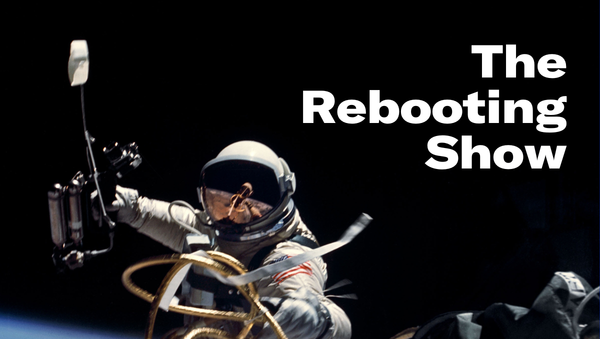The power of doing nothing
Ribbon-cutting ceremonies are always crowded

Welcome to one newsletter that isn’t about Robinhood, r/WallStreetBets or Clubhouse. Instead, I wrote about why inaction sometimes beats frenetic activity. Maybe it’s life in Miami, but I’ve come around to the power of sitting still -- and why “magazines” are in for a comeback of sorts.
The power of doing nothing

Every small company is like a shark: It has to keep swimming. The best part of being a small and scrappy team is there is no choice but to engage in furious activity as you seek to find a sustainable business model. That means not wasting a lot of time with structure or concerns about confusing your audience. The best way to know what people will buy is to throw a lot against the wall, see what sticks.
That flood-the-zone approach has its limits. You start to work against yourself. The impulse from your sub-15 people days remains -- it’s part of the company’s DNA, after all -- to always do more, try new things, offer new programs. What I found is there’s strength in resisting these urges often in favor of patience. Rafat Ali, CEO of Skift, years ago called it “going slow to go fast.”
This is harder than it seems. The impulse as a motivated person and ambitious business is to always do more. And often you’ll get immediate rewards that reinforce the notion that you should always do more. Send more email, you’ll get more responses. Add more categories, you’ll get more awards submissions. Have more events, you’ll sell more tickets. Publish more stories, you’ll get more traffic. More calls and emails, more sales. More launches, more press coverage and RTs and weird LinkedIn messages from enterprise salespersons. And so on. What’s more, your competitors are doing more. So surely you should or be left behind.
Companies tend to rightly emphasize initiative. You don’t want people punching in, punching out. What happens is people scramble to be part of the new since that gets the top people’s focus and is a way to stand out. That leaves out the boring work of building existing products, fixing rickety infrastructure or simply pointing out why a new initiative is a distraction. There’s a reason ribbon-cutting ceremonies attract a crowd while maintenance work is often a lonely, thankless endeavor.
I found over a decade at Digiday we had periods of intense expansion -- new brands, new events, a new magazine, new podcasts, etc -- and then a time of retrenchment and building. The latter were my preferred periods, even with the excitement of a new launch. Patience is not just a virtue; it is a competitive advantage in a frenetic, impatient world.
The constant churn and burn of new initiatives, and fire drills, has a high cost. There is rightly more focus on mental health at the workplace. But often the steps taken are window dressing: meditation sessions, mental health days, etc. The biggest source of work stress, in my experience, comes from being tasked with doing far more with less.
You dilute your brand. One of my favorite all-time memos, the Peanut Butter Manifesto in late 2006, described how Yahoo’s strategy amounted to “a thin layer of investment spread across everything we do and thus we focus on nothing in particular.” Constant launches lead to many mediocre products. More often than not, you’re better off improving on what you have than trying something new.
The opportunity costs are higher than you know. As a company matures, you start to understand what is working. Constantly being attracted to new initiatives inevitably bleeds scare resources from doing more of what’s working. You have scarce inputs to bring to bear to create outputs.
People confuse launches with value. Starting something new is a prerequisite for creating value, but it is merely a step. The hard work isn’t the Prosecco toast with plastic champagne glasses whose stands always fall off. The hard work is in Day 2+ when the building takes place. It’s important to have a company culture that rewards the unglamorous work of building vs the sexier work of launching.
Creating new variables messes with your insights. As a company grows, so too does its data. I found that means a shift from the early days where gut instincts and market experience do most of the job. Instead, you need to understand data to improve products. Adding an extraneous new feature to a subscription product, for example, might seem like “doing something” to sell more subs, but it can often have the opposite result as you mess up your measurement framework.
Revenge of the magazine
The media industry is in the throes of an unbundling phase. The cable bundle has given way to an incomprehensibly chaotic streaming universe that, speaking personally, often makes me miss the cable bundle. I have more time on my hands these days, but spending it strategizing my “entertainment stack” isn’t ideal. The explosion of individual newsletters, driven by Substack, is another example of unbundling, with its confusion and downsides too.
If the past is prologue, unbundling phases are quickly followed by rebundling. But what does that rebundling look like? In streaming, we’re seeing the emergence of the major streaming services with massive subscription bases -- Netflix, Disney+, HBO Max -- and steps to the rebundling of some niche streamers, such as WWE ditching its standalone streaming service linking up with NBCU’s Peacock. Newsletters will have a chaotic year ahead, as Substack competitors proliferate with their own flavors. My bet: the personality-driven “creator” field remains fairly niche as a middle class fails to emerge. Instead, we’ll see a revival of… the magazine.
At their best, newsletters do the job of a magazine with curation driven by a unique sensibility, bundling together individual pieces of content so the sum is greater than its parts and ability to weave in ads that make sense in the bundle.
Courses are the new commerce
Publishers will always fall for the siren call of incremental revenue. The decline of the direct-sold digital display business, and the low rates in programmatic, led to a scramble to create new ways to extract money from audiences. One of the most successful of the past five years: commerce plays. For the most part, this is a fancy term for gift guides with affiliate links. But these revenue lines have become substantial at many publishers.
One of the more promising revenue growth areas is around courses. Without a doubt, the appetite for digital courses is a pandemic feature as we are stuck at home and the bar gets lowered for what qualifies as a good use of our time. (I have spent an alarming amount of time observing our new robot vacuum.) But the growth of Masterclass has shown there is a market in offering up expertise -- and new platforms that make it easy to execute. This is a growing area of monetization for newsletter creators and niche publishers. Some efforts that have caught my eye:
- Lenny Rachitsky is the prototype for Substack star as a practitioner with an accidental media company. The former Airbnb product manager is offering a three-week group product management course for $950.
- Not everything needs to be paid. Front Office Sports, one of my favorite B2B brands, has a smart new free courses initiative with Pepsi as an underwriter. FoS does all the heavy lifting, but Pepsi is the presenting sponsor with its executives serving as instructors. For Pepsi, this is a way to establish itself as top of mind with sports marketers.
- Scott Galloway has become ubiquitous. What’s interesting is he’s building a media company that monetizes through courses. His company, Section4, has several group “sprint” courses that cost $750. Galloway, a longtime NYU professor, knows where the money is. (NYU’s undergrad tuition is $53k.)
Things to check out
I mark the aging process by the different permutations of the Business Insider brand. Sorry, that’s now Insider. The artist formerly known as BI, formerly knowns as The Business Insider, formerly Silicon Alley Insider is cleaning up its sprawling brand architecture to simply be Insider. RIP Cheese Insider. (One correction from last week: I shortchanged Insider’s 2020 revenue growth: It was 30 percent, not 20 percent.)
Finding a sustainable model for local news is the hardest of the hard problems in media. The newsletter boom is giving rise to new efforts at scaled down local publications. These seem mostly 2-3 person operations. This week, 6am City added new funding to build out its network of publications mostly in the Southeast. Axios is up and running in Tampa Bay and the Twin Cities with three more en route this year. David Plotz’s Citycast is marrying newsletters and podcasts in a push that’s kicking off in Chicago and Denver next month.
If you’re into brevity, Axios is giving a course on its powers next week. Hopefully, it will also show a bit of Axios HQ, the software and services product Axios is selling to companies wanting to get to the point.
If you’re interested in podcasting, Bryan Barletta has a newsletter called Sounds Profitable that’s dedicated to the business side of audio, in particular ad tech. (Side note: Bryan was the first person I hired at Digiday many years ago.) Check it out.




